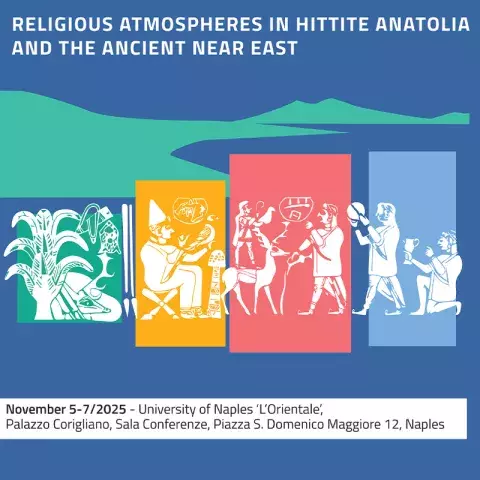
Religious atmospheres in Hittite Anatolia and the Ancient Near East.
International conference, Naples, 5–7 November 2025.
Organized by Michele Cammarosano & Alessandra Gilibert in the frame of the project The art of the stage in Bronze Age Anatolia. Reconstructing Hittite festivals using texts, images and comparative cultural anthropological evidence (directed by Michele Cammarosano, Alessandra Gilibert, and Sebastiano Mannia).
The concept of ‘atmosphere’, initially developed within the fields of phenomenology and aesthetics and later applied to other disciplines such as architecture, sociology, human geography, and theology, is now beginning to be employed also in the study of the history of religions. The historian of religions Martin Radermacher suggests understanding atmospheres as “the realized sensory, affective and semantic potential of socio-spatial arrangements”, that facilitate semantic attributions, reduce complexity, and stabilize social and communicative systems (Religion und Atmosphäre, 2024, 18, our translation).
Of particular interest for applying the concept of atmospheres to the study of past civilizations is the approach proposed by the German philosopher Gernot Böhme, where atmospheres are examined from the perspective of the production aesthetics, or, in Platonic terms, of τέχνη φανταστική. In this way, they are related to the paradigm of the ‘art of the stage’: the design of spatial, material and sensory arrangements aimed at eliciting, under specific conditions, certain sensations in participants (for a concise account, see his paper The art of the stage set as a paradigm for an aesthetics of atmospheres, 2013). The potential for applying this approach to ancient cultures is highlighted by today’s
developments exploring sensory dimensions, cf. the spatial, somatic, affective, or material ‘turns’, and by new data and perspectives from disciplines such as anthropology, ethnoarchaeology, archaeobotany, archaeomusicology, visual studies, performance studies, and festive studies. A particularly fruitful area for exploring atmospheres in the ancient Near Eastern world, including in Hittite Anatolia, is the cultic sphere, for which an extensive and rich corpus of textual and material sources is available.
The project The Art of Stage in Late Bronze Age Anatolia aims to contribute to the reconstruction of Hittite religious atmospheres through the dual case study of the cults of the sacred city of Arinna, as known from written sources, and the Sphinx Gate at the site of Alacahöyük. The conference seeks to present the main findings achieved within the project while situating them within the broader context of the ancient Near East, and to place the chosen case studies and methodological approach in dialogue with other case studies and perspectives.




